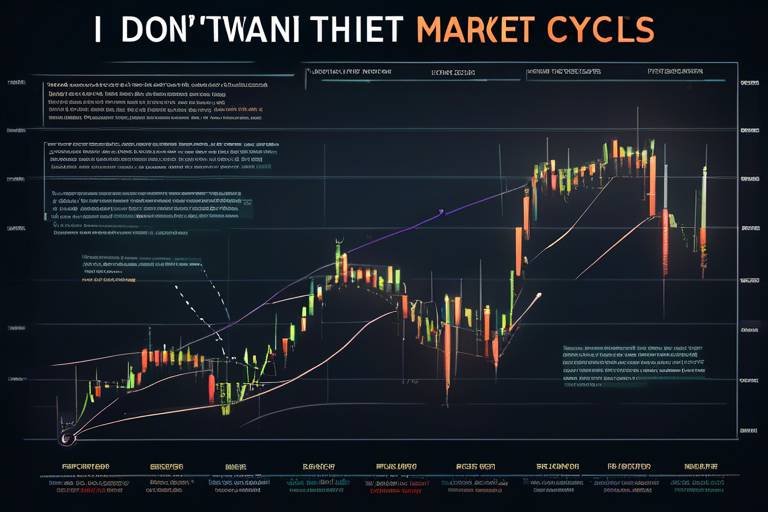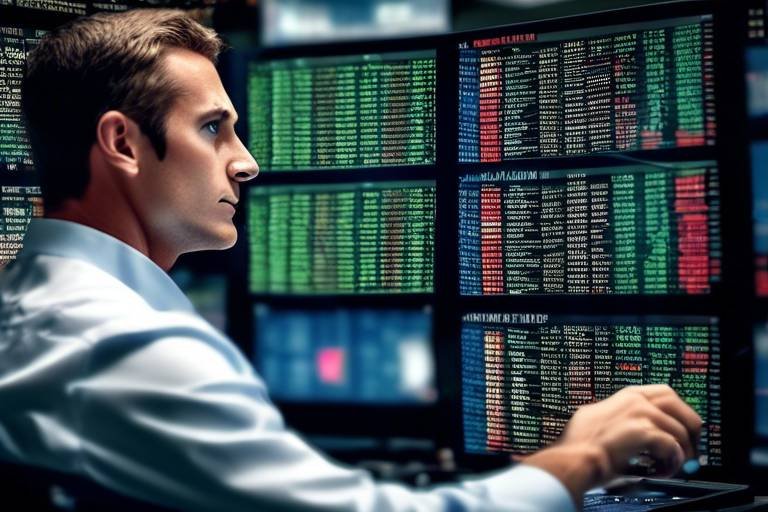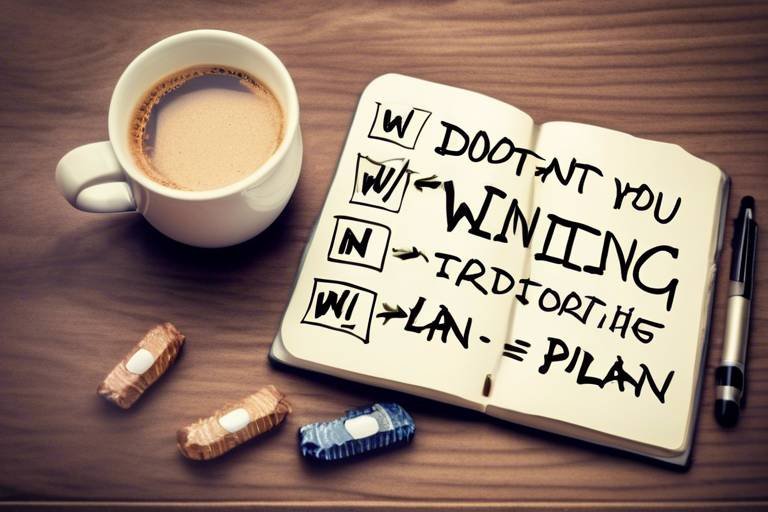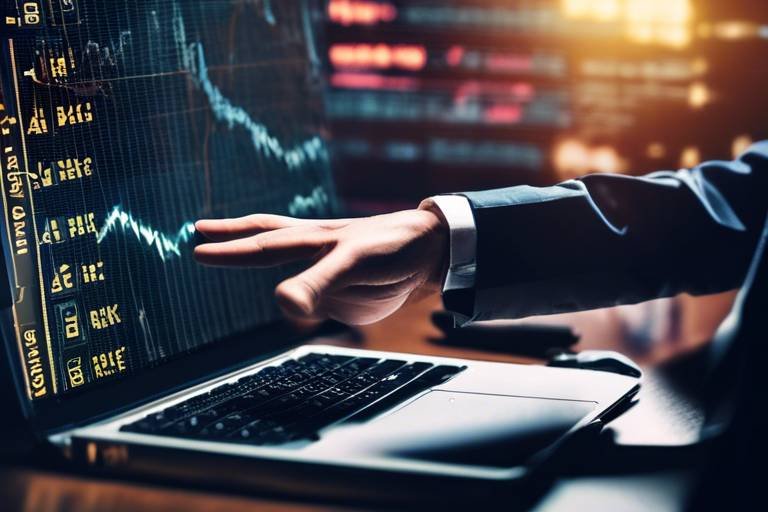Using Backtesting to Improve Your Strategy
In the ever-evolving world of trading, the quest for a winning strategy can often feel like searching for a needle in a haystack. But what if I told you that there’s a way to sift through that haystack with precision? Enter backtesting—a powerful method that allows traders to simulate their strategies against historical market data. By doing so, traders can refine their techniques, identify potential pitfalls, and ultimately increase their chances of success when it comes to live trading. Imagine being able to test your ideas in a controlled environment before risking real money; that’s the magic of backtesting!
Backtesting doesn’t just stop at testing the waters; it dives deep into the intricacies of your trading strategy. It’s like having a time machine that lets you go back and see how your strategy would have performed in different market conditions. This insight is invaluable, as it helps traders understand not only the effectiveness of their strategies but also how they might react under various circumstances. So, whether you're a seasoned trader or just starting out, understanding backtesting can be the key to unlocking your trading potential.
Now, you might be wondering, what exactly does backtesting involve? Well, it starts with defining a clear trading strategy, followed by applying it to historical data. This process includes analyzing the results to evaluate the strategy's performance based on key metrics. Think of it as a dress rehearsal before the main event—getting everything right before the spotlight hits. The beauty of backtesting lies in its ability to provide concrete data and insights, allowing traders to make informed decisions rather than relying on gut feelings alone.
As we delve deeper into the world of backtesting, we’ll uncover its myriad benefits, common pitfalls to avoid, and the tools available to assist you in this journey. By the end of this article, you’ll not only understand how to leverage backtesting to improve your trading strategy but also how to interpret the results effectively. So, buckle up and get ready to take your trading game to the next level!
Backtesting is the process of testing a trading strategy using historical data to evaluate its effectiveness. This section will cover the fundamentals of backtesting and its significance in trading.
Utilizing backtesting offers numerous advantages, including risk management, performance evaluation, and strategy optimization. Here, we will delve into the key benefits that backtesting provides to traders.
Effective risk management is crucial for successful trading. This subsection discusses how backtesting can help identify potential risks and mitigate losses in various market scenarios.
Understanding drawdowns is essential for traders. This part will explain how backtesting reveals historical drawdowns and their implications for future trading decisions.
Position sizing plays a critical role in risk management. This section will explore how backtesting assists traders in determining optimal position sizes based on historical performance.
Evaluating a strategy's performance is vital for making informed trading decisions. This section highlights how backtesting allows traders to analyze key performance metrics effectively.
Even experienced traders can make mistakes during backtesting. This section will outline common pitfalls and how to avoid them for more reliable results.
Overfitting occurs when a strategy is too tailored to historical data. This subsection discusses the dangers of overfitting and how to maintain a balance.
Market conditions change over time, and ignoring this can lead to poor strategy performance. This part will emphasize the importance of considering varying market environments during backtesting.
Various tools and software are available to assist traders in backtesting their strategies. This section will review popular options and their features.
Many trading platforms offer built-in backtesting features. This subsection will highlight some of the most user-friendly platforms for traders to utilize.
Custom backtesting software can provide advanced features for serious traders. This part will explore the benefits and considerations of using tailored solutions for backtesting.
Understanding the results of backtesting is crucial for strategy improvement. This section will guide traders on how to interpret and apply backtesting outcomes effectively.
Key performance indicators (KPIs) help evaluate a strategy's success. This subsection will discuss essential KPIs to consider when analyzing backtesting results.
Adapting strategies based on backtesting results is vital for ongoing improvement. This part will provide insights on how to make informed adjustments to enhance trading strategies.
In conclusion, backtesting is a powerful tool for traders seeking to refine their strategies. By understanding its benefits, avoiding common mistakes, and leveraging the right tools, traders can significantly improve their chances of success in the markets.
- What is backtesting? Backtesting is the process of testing a trading strategy on historical data to see how it would have performed.
- Why is backtesting important? It helps traders refine their strategies, manage risks, and make informed decisions based on historical performance.
- Can backtesting guarantee success? While backtesting can improve your chances, it cannot guarantee success due to changing market conditions.
- What tools can I use for backtesting? There are various trading platforms and custom software available that offer backtesting features.
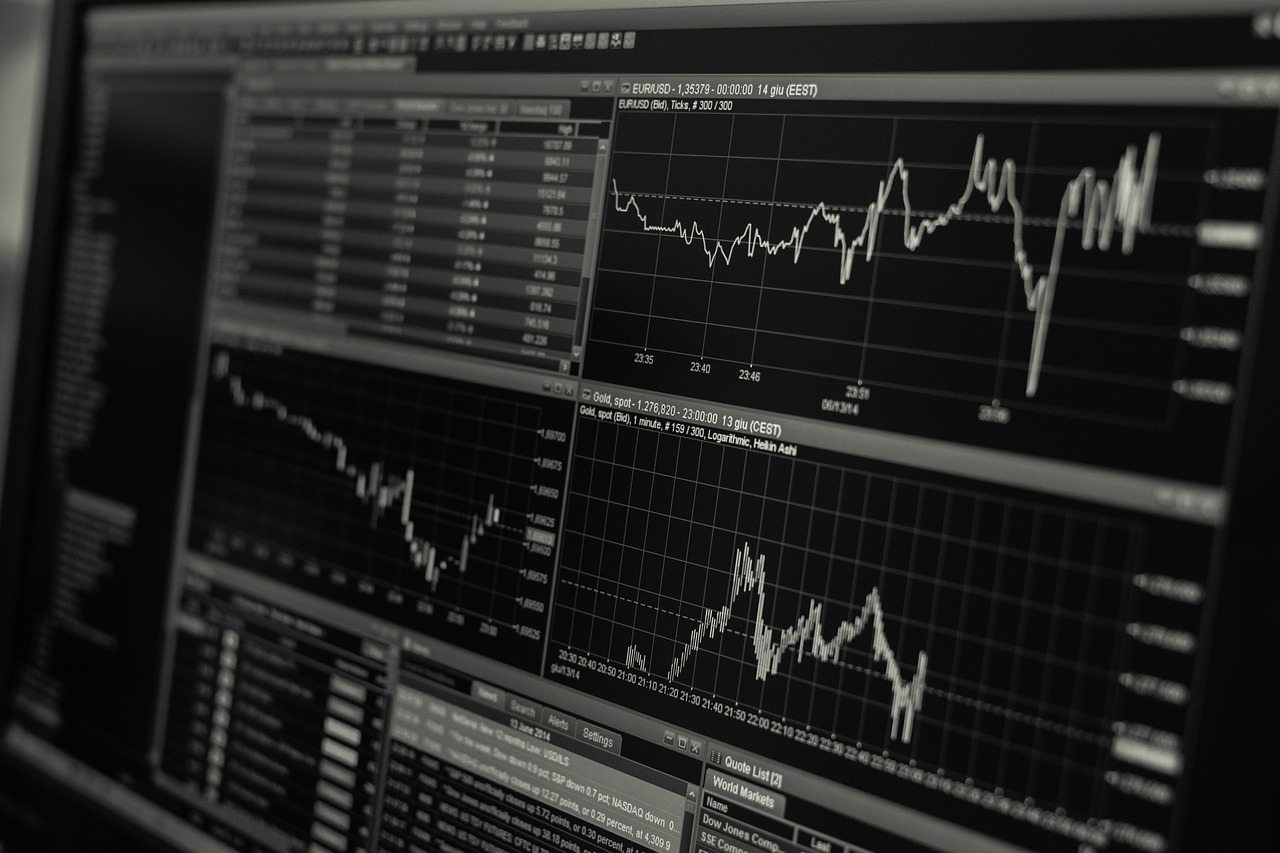
Understanding Backtesting
This article explores how backtesting can enhance trading strategies by simulating past market conditions, allowing traders to refine their techniques and increase their chances of success in live trading environments.
Backtesting is the process of testing a trading strategy using historical data to evaluate its effectiveness. Think of it as a time machine for traders, allowing you to step back into the past and see how your strategy would have performed under various market conditions. By analyzing this historical data, traders can gain valuable insights into whether their strategies are sound or need adjustments. It’s like rehearsing for a play—if you know your lines and cues, you're more likely to nail the performance on opening night.
When you backtest a strategy, you’re essentially playing out a scenario where you apply your trading rules to past data. This method helps in identifying potential weaknesses and strengths before risking real money. The significance of backtesting cannot be overstated; it serves as a foundational step for any trader looking to build a robust trading plan. Without it, you might as well be throwing darts blindfolded, hoping to hit a bullseye.
There are several key components to consider when backtesting:
- Historical Data: The quality and relevance of your historical data are crucial. If the data is flawed, your backtesting results will be misleading.
- Strategy Rules: Clearly defined rules are essential. This includes entry and exit points, risk management strategies, and position sizing.
- Market Conditions: Different market environments can yield different results. It's important to test your strategy across various conditions—bull markets, bear markets, and sideways trends.
Moreover, backtesting isn’t just about running numbers; it’s about interpreting them. Traders must analyze the results critically, looking for patterns and anomalies that could inform future decisions. Just like a detective piecing together clues, you need to connect the dots to understand what the data is telling you. By doing so, you can refine your strategy, making it more resilient to the unpredictable nature of live trading.
In summary, understanding backtesting is essential for any trader serious about improving their strategy. It’s not merely a checkbox on your trading to-do list; it’s a comprehensive approach that can significantly enhance your trading performance. So, if you’re not already incorporating backtesting into your routine, it’s high time you started. After all, in the world of trading, knowledge is power, and backtesting is one of the most powerful tools in your arsenal.
Utilizing backtesting offers numerous advantages, including risk management, performance evaluation, and strategy optimization. Here, we will delve into the key benefits that backtesting provides to traders.
Effective risk management is crucial for successful trading. This subsection discusses how backtesting can help identify potential risks and mitigate losses in various market scenarios.
Understanding drawdowns is essential for traders. This part will explain how backtesting reveals historical drawdowns and their implications for future trading decisions.
Position sizing plays a critical role in risk management. This section will explore how backtesting assists traders in determining optimal position sizes based on historical performance.
Evaluating a strategy's performance is vital for making informed trading decisions. This section highlights how backtesting allows traders to analyze key performance metrics effectively.
Even experienced traders can make mistakes during backtesting. This section will outline common pitfalls and how to avoid them for more reliable results.
Overfitting occurs when a strategy is too tailored to historical data. This subsection discusses the dangers of overfitting and how to maintain a balance.
Market conditions change over time, and ignoring this can lead to poor strategy performance. This part will emphasize the importance of considering varying market environments during backtesting.
Various tools and software are available to assist traders in backtesting their strategies. This section will review popular options and their features.
Many trading platforms offer built-in backtesting features. This subsection will highlight some of the most user-friendly platforms for traders to utilize.
Custom backtesting software can provide advanced features for serious traders. This part will explore the benefits and considerations of using tailored solutions for backtesting.
Understanding the results of backtesting is crucial for strategy improvement. This section will guide traders on how to interpret and apply backtesting outcomes effectively.
Key performance indicators (KPIs) help evaluate a strategy's success. This subsection will discuss essential KPIs to consider when analyzing backtesting results.
Adapting strategies based on backtesting results is vital for ongoing improvement. This part will provide insights on how to make informed adjustments to enhance trading strategies.
In conclusion, backtesting is a powerful tool for traders seeking to refine their strategies. By understanding its benefits, avoiding common mistakes, and leveraging the right tools, traders can significantly improve their chances of success in the markets.
Q1: What is backtesting?
A1: Backtesting is the process of testing a trading strategy using historical data to see how it would have performed in the past.
Q2: Why is backtesting important?
A2: Backtesting helps traders identify the strengths and weaknesses of their strategies before risking real money in live trading.
Q3: What are common mistakes in backtesting?
A3: Common mistakes include overfitting the strategy to historical data and ignoring changing market conditions.
Q4: What tools can I use for backtesting?
A4: There are many trading platforms and custom software solutions that offer backtesting features to help traders analyze their strategies.
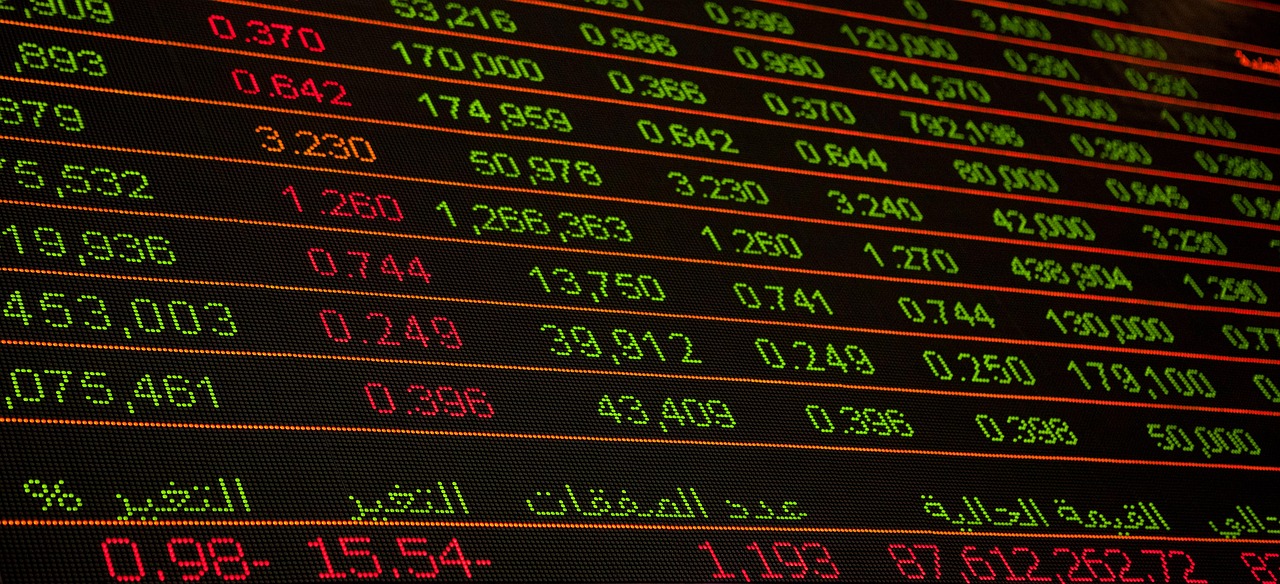
Benefits of Backtesting
Backtesting is not just a buzzword in the world of trading; it’s a game-changer that can significantly enhance your trading strategies. By simulating past market conditions, traders can refine their techniques, making informed decisions based on historical data. Imagine trying to navigate a maze without knowing the layout—backtesting provides that layout, guiding you through the twists and turns of the market. Now, let’s dive into some of the key benefits that make backtesting an essential tool for traders.
One of the most significant advantages of backtesting is its role in risk management. Effective risk management is crucial for successful trading, and backtesting helps identify potential risks before they become costly mistakes. By analyzing historical data, traders can see how their strategies would have performed during various market conditions, allowing them to prepare for similar scenarios in the future. This proactive approach not only minimizes losses but also boosts confidence in their trading decisions.
Moreover, backtesting enables traders to evaluate their performance. How do you know if a strategy is working? By looking at historical performance metrics! Backtesting allows you to analyze key performance indicators (KPIs) such as the win/loss ratio, average return per trade, and maximum drawdown. This analysis is akin to a coach reviewing game footage to improve team performance—by understanding what worked and what didn’t, traders can tweak their strategies for better results.
Another compelling benefit of backtesting is strategy optimization. In the ever-evolving world of trading, a strategy that worked yesterday may not work today. Backtesting provides insights into how strategies can be adjusted to adapt to changing market conditions. For instance, if a trader notices that their strategy underperformed during certain market trends in the past, they can make necessary adjustments to enhance its effectiveness moving forward. This continuous improvement cycle is vital for long-term success.
Let’s not forget about the psychological aspect of trading. Backtesting can help traders build confidence in their strategies. When traders see that their methods would have yielded positive results historically, they are more likely to stick to their plans during live trading, rather than succumbing to emotional decisions driven by fear or greed. It's like having a safety net; knowing that your strategy has a solid foundation allows you to trade with a clearer mind.
In summary, backtesting offers a multitude of benefits that can elevate a trader’s performance. From effective risk management and performance evaluation to strategy optimization and psychological resilience, the advantages are clear. By leveraging backtesting, traders can refine their techniques and increase their chances of success in live trading environments.
- What is backtesting? Backtesting is the process of testing a trading strategy using historical data to evaluate its effectiveness.
- Why is backtesting important? It helps traders identify potential risks, evaluate performance, and optimize strategies based on historical data.
- Can backtesting guarantee success? While backtesting provides valuable insights, it cannot guarantee future success due to changing market conditions.
- What tools can I use for backtesting? There are various trading platforms and custom software available that offer backtesting features.

Risk Management
Effective is the backbone of successful trading. Without it, traders are essentially navigating a stormy sea without a compass. Backtesting provides a unique opportunity to identify potential risks and formulate strategies to mitigate them before they become costly mistakes in live trading environments. By simulating various market conditions, traders can foresee how their strategies might perform under different circumstances, allowing them to make informed decisions.
One of the primary benefits of backtesting in risk management is the ability to identify potential drawdowns. Drawdowns refer to the decline from a historical peak in the value of an investment or trading account. Understanding these drawdowns is essential for traders, as it helps in setting realistic expectations and preparing psychologically for potential losses. Through backtesting, traders can analyze historical drawdowns and their implications for future trading decisions, ensuring they are not caught off guard when the market turns against them.
Moreover, backtesting plays a crucial role in determining position sizing. Position sizing is the amount of capital allocated to a particular trade, and it can significantly impact a trader's overall risk exposure. By analyzing past performance data, traders can optimize their position sizes to align with their risk tolerance and the volatility of the market. This means that instead of risking a fixed percentage of their capital on every trade, traders can adjust their position sizes based on the historical volatility of the asset they are trading.
In essence, backtesting equips traders with the necessary tools to make educated decisions regarding their risk management strategies. By identifying potential risks, understanding drawdowns, and determining optimal position sizes, traders can navigate the complexities of the market with greater confidence and a significantly reduced risk of catastrophic losses. The goal is to create a safety net that allows for profitable trading while minimizing exposure to unforeseen market events.
- What is backtesting? Backtesting is the process of testing a trading strategy using historical data to evaluate its effectiveness.
- Why is risk management important in trading? Risk management is crucial because it helps traders minimize potential losses and protect their capital.
- How can backtesting help with position sizing? Backtesting allows traders to analyze historical performance and determine optimal position sizes based on risk tolerance and market volatility.
- What are drawdowns, and why should traders care? Drawdowns are declines from a peak in investment value, and understanding them helps traders set realistic expectations and prepare for potential losses.

Identifying Drawdowns
When it comes to trading, understanding drawdowns is like knowing the speed bumps on your journey. A drawdown refers to the reduction of one's capital after a series of losing trades, and recognizing these dips is crucial for any trader aiming to maintain a healthy portfolio. Imagine you're cruising along a highway, and suddenly you hit a pothole; that’s what a drawdown feels like in the trading world. It’s essential to identify these drawdowns to prepare yourself mentally and financially for the inevitable fluctuations in the market.
Backtesting allows traders to simulate past market conditions, providing a clear picture of how a strategy would have performed during various downturns. By analyzing historical data, traders can pinpoint the maximum drawdown—a significant drop from a peak to a trough—giving them insights into how their strategies might behave in the future. This analysis is not just about the numbers; it’s about understanding the psychology behind those numbers. When traders see a drawdown in their backtesting results, they can ask themselves: How did I feel during this period? What decisions did I make? This reflection is vital for improving emotional resilience in live trading.
Moreover, it’s not just about identifying drawdowns; it's about understanding their implications. A trader might experience a maximum drawdown of 20%, which can be alarming. However, if they know that their strategy has historically recovered from similar drawdowns, they might feel more confident in sticking to their plan. This is where backtesting shines—it doesn’t just show you the numbers; it tells a story. Here are a few key points to consider when identifying drawdowns:
- Historical Context: Analyze how often similar drawdowns occurred in the past and how long it took to recover.
- Risk Tolerance: Assess whether the drawdown aligns with your personal risk tolerance and investment goals.
- Adjustment Opportunities: Use drawdown data to refine your strategy and improve risk management techniques.
In essence, identifying drawdowns through backtesting isn’t just about crunching numbers; it’s about gaining a deeper understanding of your trading strategy and your own reactions to market volatility. By embracing the lessons learned from historical drawdowns, traders can enhance their strategies, making them more robust and resilient against future market challenges.
- What is a drawdown? A drawdown is the reduction of an investment's peak value to its lowest point, typically measured as a percentage.
- How can backtesting help identify drawdowns? Backtesting allows traders to simulate past market conditions to see how their strategies would have performed during drawdowns.
- Why is understanding drawdowns important? Recognizing drawdowns helps traders manage risk, prepare psychologically for losses, and refine their strategies for better performance.

Position Sizing
Position sizing is one of the most critical aspects of trading that can make or break your trading strategy. Imagine you're at a casino, and you have a limited amount of chips to play with. If you bet too much on one hand, you could lose everything in an instant. Conversely, if you bet too little, you might miss out on significant wins. This analogy perfectly encapsulates the importance of position sizing in trading. It’s all about finding that sweet spot where you can maximize your potential returns while minimizing your risks.
In the realm of trading, position sizing refers to the amount of capital you allocate to a particular trade. The right position size can help you withstand the inevitable ups and downs of the market without getting wiped out. But how do you determine the optimal position size? That's where backtesting comes into play. By analyzing historical data, traders can identify patterns and trends that inform their position sizing decisions.
One effective method for calculating position size is the Kelly Criterion, which helps traders determine the optimal amount to bet based on their win rate and the odds of the trade. Here’s a simplified formula:
Position Size (Win Rate - (1 - Win Rate)) / Odds
However, while the Kelly Criterion is a valuable tool, it's essential to approach it with caution. Many traders opt for a more conservative approach by risking only a small percentage of their capital on any given trade—typically between 1% and 3%. This strategy allows for a more sustainable trading practice, especially in volatile markets.
When backtesting your strategy, it’s crucial to include various position sizes to see how they would have performed under different market conditions. A well-structured backtest can reveal how varying your position sizes impacts your overall profitability and risk exposure. For instance, if a particular position size consistently leads to larger drawdowns, it might be wise to adjust your strategy accordingly.
Moreover, risk management plays a pivotal role in determining position sizes. Traders should consider factors like stop-loss levels and the overall volatility of the asset in question. For example, if you’re trading a highly volatile stock, you might want to reduce your position size to mitigate the risk of significant losses. Conversely, if you’re trading a more stable asset, a larger position might be justified.
In summary, effective position sizing is not just a number; it’s a strategic decision that can significantly impact your trading success. By leveraging backtesting to refine your approach, you can find a balance that maximizes your potential while keeping your risks in check. Remember, in trading, it’s not about how much you can win; it’s about how much you can afford to lose.
- What is the best way to determine position size? The best way is to consider your overall capital, risk tolerance, and the volatility of the asset you are trading. Backtesting can provide insights into optimal position sizes based on historical data.
- How often should I adjust my position size? It's advisable to review your position sizes regularly, especially after significant market movements or changes in your trading strategy.
- Can position sizing help reduce losses? Yes, effective position sizing can limit your exposure to risk, thereby reducing potential losses in adverse market conditions.

Performance Evaluation
When it comes to trading, evaluating the performance of your strategy is like checking the pulse of a patient; it tells you whether your approach is alive and kicking or in dire need of resuscitation. Backtesting provides a treasure trove of data that allows traders to analyze how their strategies would have fared in past market conditions. By diving deep into this data, you can uncover critical insights that inform your future trading decisions.
One of the first steps in performance evaluation is to look at key performance metrics. These metrics serve as the backbone of your analysis, helping you understand not just how much profit you made, but also how consistently you achieved those profits. Some of the most essential metrics to track include:
- Net Profit: This is the total profit after deducting all losses and expenses. It gives you a clear picture of your overall success.
- Win Rate: This metric indicates the percentage of trades that resulted in a profit. A higher win rate often correlates with a more effective strategy.
- Risk-to-Reward Ratio: This ratio compares the potential profit of a trade to the potential loss. A favorable ratio can significantly enhance your trading outcomes.
- Maximum Drawdown: This measures the largest peak-to-valley loss experienced during the backtesting period, providing insight into the risk of your strategy.
Understanding these metrics is crucial, but it’s also important to put them into context. For instance, a high win rate might seem appealing, but if your risk-to-reward ratio is unfavorable, you could still end up losing money in the long run. Think of it like a basketball player who makes a lot of shots but misses the crucial game-winners; it’s not just about quantity but also about quality.
Moreover, backtesting allows you to visualize your strategy’s performance over time through charts and graphs. These visual representations can reveal trends and patterns that numbers alone might obscure. For example, a line graph showing your equity curve can highlight periods of drawdown or growth, making it easier to identify when your strategy is underperforming.
As you evaluate your performance, always remember that the past does not guarantee future success. Market conditions are constantly changing, and a strategy that worked well in a bull market may not perform similarly in a bear market. Therefore, it's essential to continually adapt and refine your strategy based on the insights gained from backtesting.
In conclusion, performance evaluation through backtesting is not just a one-time task; it's an ongoing process that requires diligence and adaptability. By regularly assessing your trading strategies and making informed adjustments, you can enhance your chances of success in the dynamic world of trading.
1. What is the best way to backtest my trading strategy?
The best way to backtest a trading strategy is to use historical data with a reliable backtesting software or platform. This allows you to simulate trades based on past market conditions and analyze the results effectively.
2. How can I avoid overfitting my strategy during backtesting?
To avoid overfitting, ensure that your strategy is not overly complex and is adaptable to different market conditions. Use a separate dataset for validation to test how well your strategy performs outside of the data it was trained on.
3. What are some common metrics to evaluate my trading strategy?
Common metrics include net profit, win rate, risk-to-reward ratio, and maximum drawdown. These metrics provide a comprehensive overview of your strategy's performance and risk profile.
4. How often should I backtest my trading strategy?
You should backtest your trading strategy regularly, especially after making significant changes or when market conditions shift. This ensures that your strategy remains relevant and effective.

Common Backtesting Mistakes
Even the most seasoned traders can stumble when it comes to backtesting their strategies. It’s easy to get caught up in the excitement of analyzing historical data, but there are several common pitfalls that can lead to misleading results and ultimately hurt your trading performance. By being aware of these mistakes, you can create a more robust backtesting process that enhances your trading strategy.
One of the most significant mistakes traders make is overfitting the strategy. This occurs when a strategy is excessively tailored to past data, making it perform exceptionally well in historical tests but poorly in live markets. Think of it like trying to fit a square peg into a round hole; while it might seem to work perfectly in one scenario, it’s unlikely to hold up under different conditions. To avoid this trap, it’s essential to maintain a balance between optimizing your strategy and ensuring it remains adaptable to future market changes.
Another critical error is ignoring market conditions. The financial markets are dynamic, and what worked yesterday may not work today. By neglecting to account for varying market environments—such as volatility, trends, or economic events—you risk applying a strategy that may fail in a different context. For instance, a strategy that performs well in a bullish market might struggle during a bearish phase. Thus, it’s vital to analyze how your strategy behaves under different market conditions to ensure it remains resilient.
Additionally, many traders overlook the importance of data quality during backtesting. Using inaccurate or incomplete historical data can lead to skewed results. It’s like cooking without a proper recipe; you might end up with a dish that tastes terrible. Therefore, always ensure that your historical data is reliable and comprehensive. This includes checking for any gaps, anomalies, or errors that could impact your analysis.
Furthermore, neglecting to account for trading costs is another common mistake. Many traders forget to factor in commissions, slippage, or spreads when evaluating their backtesting results. This oversight can significantly inflate the perceived profitability of a strategy. To get a more realistic picture, always include these costs in your backtesting calculations. After all, what’s the point of a winning strategy if the costs eat away at your profits?
Lastly, failure to document your backtesting process can lead to confusion and inconsistency in your trading approach. Keeping a detailed record of your backtesting methodology, including the parameters used, the data analyzed, and the outcomes observed, is crucial. This documentation serves as a valuable reference for future analyses and helps you understand the rationale behind your trading decisions.
In summary, while backtesting is an invaluable tool for refining trading strategies, it’s essential to be aware of common mistakes that can undermine your efforts. By avoiding overfitting, considering market conditions, ensuring data quality, accounting for trading costs, and documenting your process, you can enhance the reliability of your backtesting results and improve your chances of success in the live market.
- What is backtesting? Backtesting is the process of testing a trading strategy using historical data to evaluate its effectiveness.
- Why is backtesting important? Backtesting helps traders refine their strategies by simulating past market conditions, allowing for better decision-making in live trading.
- What are the common mistakes in backtesting? Common mistakes include overfitting, ignoring market conditions, using poor-quality data, neglecting trading costs, and failing to document the process.
- How can I avoid overfitting? To avoid overfitting, maintain a balance between optimizing your strategy and ensuring it remains adaptable to future market changes.

Overfitting the Strategy
Overfitting is a common pitfall that many traders encounter when developing their strategies through backtesting. Essentially, it occurs when a trading strategy is excessively tailored to fit historical data, resulting in a model that performs exceptionally well in the past but fails to deliver similar results in live trading conditions. Think of it like crafting a perfectly tailored suit; it may fit like a glove on the mannequin, but when worn, it might not accommodate the wearer's movements or changes in body shape.
When a strategy is overfitted, it often incorporates too many variables or complexities that are unique to the historical dataset. This can lead to a false sense of security for traders, as they may believe they have discovered a "holy grail" strategy. However, the reality is that these strategies tend to lack robustness and adaptability when faced with new market conditions. In other words, they may shine in a backtest but crumble under the pressure of real-world trading.
To illustrate the concept of overfitting, consider the following scenario: a trader tests a strategy that uses ten different indicators to predict market movements. While the strategy may show impressive results over a specific historical period, it could be simply responding to noise in the data rather than identifying genuine market trends. In this case, the strategy's performance is not indicative of its future success, as it may not hold up when market dynamics shift.
To avoid falling into the overfitting trap, traders should keep the following points in mind:
- Simplicity is Key: Strive for a strategy that is straightforward and easy to understand. Often, less is more when it comes to trading strategies.
- Test on Multiple Data Sets: Validate your strategy on different historical periods and market conditions to ensure its robustness.
- Avoid Excessive Optimization: Resist the urge to tweak your strategy for the best possible backtest results. Instead, focus on creating a strategy that performs consistently across various scenarios.
In summary, while backtesting is an invaluable tool for traders, it's essential to be cautious of overfitting. By maintaining a balanced approach and prioritizing simplicity, traders can develop more resilient strategies that stand the test of time and adapt to changing market conditions.
- What is overfitting in trading? Overfitting occurs when a trading strategy is too closely aligned with historical data, making it less effective in real-world trading.
- How can I avoid overfitting? To avoid overfitting, keep your strategy simple, test it across various datasets, and avoid excessive optimization for past performance.
- Why is backtesting important? Backtesting allows traders to evaluate the effectiveness of their strategies based on historical data, helping them refine their techniques before live trading.

Ignoring Market Conditions
When it comes to backtesting trading strategies, one of the biggest pitfalls traders face is . Imagine trying to predict the weather by only looking at last week’s forecast—it's not going to give you the full picture, right? Similarly, when you backtest without considering the broader market environment, you're essentially setting yourself up for failure. Market conditions can change dramatically, influenced by various factors such as economic indicators, geopolitical events, and even market sentiment. If your backtest is based solely on historical data without factoring in these elements, you might end up with a strategy that performs well in a specific context but crashes in another.
For instance, let's consider two different market conditions: a bull market and a bear market. A strategy that thrives in a bull market, where prices are generally rising, may falter in a bear market, characterized by falling prices. Thus, it is crucial to analyze how your strategy would have performed under different market scenarios. Here are a few essential market conditions to consider:
- Trend Direction: Is the market trending upwards, downwards, or moving sideways?
- Volatility Levels: Are we in a period of high volatility or low volatility?
- Market Sentiment: Are traders generally optimistic or pessimistic about the market?
By incorporating these factors into your backtesting process, you can create a more robust strategy that stands the test of time, regardless of changing market conditions. Remember, the goal is not just to find a strategy that works well historically, but to develop one that can adapt to future market fluctuations. This adaptability will ultimately enhance your trading effectiveness and help you mitigate risks.
In conclusion, ignoring market conditions during backtesting is akin to sailing a ship without adjusting the sails for changing winds. To navigate the tumultuous waters of trading successfully, you must be aware of the environment around you. By integrating a comprehensive analysis of market conditions into your backtesting routine, you can significantly improve your strategy's resilience and performance.
- What is backtesting? Backtesting is the process of testing a trading strategy using historical data to evaluate its effectiveness.
- Why is it important to consider market conditions in backtesting? Market conditions can significantly affect the performance of trading strategies, and ignoring them may lead to misleading results.
- How can I identify different market conditions? Traders can analyze historical price charts, economic indicators, and market sentiment to identify the prevailing market conditions.
- What are some common mistakes in backtesting? Common mistakes include overfitting strategies to historical data and neglecting to account for varying market environments.

Tools for Backtesting
When it comes to refining your trading strategy, having the right tools at your disposal can make all the difference. Backtesting tools are essential for simulating your strategies against historical data, and they come in various forms. Whether you are a novice trader or a seasoned pro, understanding the different options available can help you choose the best fit for your needs. There are numerous platforms and software solutions designed specifically for backtesting, each offering unique features that can enhance your trading experience.
Many traders prefer using integrated backtesting features within their trading platforms. These platforms typically provide an intuitive interface that allows you to quickly set up your strategies and run tests without needing extensive programming knowledge. Some of the most popular trading platforms include:
- MetaTrader 4/5: Known for its user-friendly interface, MetaTrader offers built-in backtesting capabilities that allow you to test various strategies using historical data.
- NinjaTrader: This platform provides advanced charting tools and a robust backtesting environment, making it suitable for traders looking for comprehensive analysis.
- TradingView: While primarily a charting tool, TradingView also offers backtesting features through its Pine Script programming language, allowing for custom strategy development.
For traders seeking more advanced options, custom backtesting software can provide a tailored experience. These tools often come with enhanced functionalities, such as:
- Customizable Indicators: Create and modify indicators to suit your specific trading needs.
- Multi-Asset Testing: Test strategies across various asset classes, including stocks, forex, and cryptocurrencies.
- Advanced Analytics: Gain deeper insights with sophisticated analytics and reporting features.
However, while the allure of custom software is strong, it’s important to consider the learning curve and potential costs associated with these tools. Many traders find that starting with a robust trading platform is sufficient for their needs, especially when they are just beginning their backtesting journey. As you grow more experienced and your strategies evolve, you can then explore custom solutions that offer more flexibility and advanced features.
In summary, the tools you choose for backtesting can significantly impact your trading success. Whether you opt for a trading platform with built-in features or invest in custom software, the key is to find a solution that aligns with your trading style and goals. Remember, the right tool can not only save you time but also provide valuable insights that can lead to more informed trading decisions.
Q1: What is backtesting?
A1: Backtesting is the process of testing a trading strategy using historical data to evaluate its effectiveness before applying it in live trading.
Q2: Why is backtesting important?
A2: Backtesting allows traders to refine their strategies, assess potential risks, and gain confidence in their trading decisions based on past performance.
Q3: Can I backtest on any trading platform?
A3: Not all trading platforms offer backtesting capabilities. It's essential to choose a platform that includes this feature to effectively test your strategies.
Q4: What are common mistakes in backtesting?
A4: Common mistakes include overfitting the strategy to historical data and ignoring changes in market conditions, which can lead to unrealistic expectations.
Q5: How can I interpret backtesting results?
A5: Key performance indicators (KPIs) such as win rate, drawdown, and return on investment (ROI) are crucial for understanding the effectiveness of your strategy.

Trading Platforms
When it comes to backtesting, the right trading platform can make all the difference. These platforms not only provide access to historical data but also offer a range of tools that simplify the backtesting process. Imagine trying to navigate through a dense forest without a map—this is what backtesting without a solid platform feels like. With the right tools, traders can efficiently simulate their strategies, analyze results, and make informed decisions.
Many trading platforms come equipped with built-in backtesting features, making them user-friendly options for both novice and experienced traders. Some popular platforms include:
- MetaTrader 4 (MT4): Known for its extensive library of indicators and expert advisors, MT4 allows traders to backtest their strategies effortlessly.
- TradingView: This platform combines social networking with powerful charting tools, enabling traders to backtest strategies using historical data.
- NinjaTrader: A favorite among futures and forex traders, NinjaTrader offers advanced backtesting capabilities with detailed performance analytics.
Each of these platforms has its unique features, catering to different trading styles and needs. For example, MetaTrader 4 is often praised for its user-friendly interface, while NinjaTrader is favored for its comprehensive analytics. It's important to choose a platform that aligns with your trading goals and technical proficiency.
Moreover, some platforms allow for the customization of backtesting parameters, which can be a game-changer. This means traders can adjust variables such as time frames, risk levels, and market conditions to see how their strategies would perform under different scenarios. This flexibility is crucial because, as we all know, the markets are anything but static!
In conclusion, selecting the right trading platform is essential for effective backtesting. Not only does it streamline the process, but it also enhances the overall trading experience by providing valuable insights and data. So, before diving into backtesting, take the time to explore various platforms and find the one that fits your trading style like a glove.
- What is backtesting? Backtesting is the process of testing a trading strategy using historical data to evaluate its effectiveness.
- Why is backtesting important? It helps traders refine their strategies, manage risks, and increase their chances of success in live trading.
- Can I backtest on any trading platform? Not all platforms have backtesting capabilities. It's essential to choose a platform that offers this feature.
- What should I look for in a trading platform for backtesting? Look for user-friendly interfaces, customization options, and comprehensive analytical tools.

Custom Backtesting Software
When it comes to backtesting, the right tools can make all the difference, and that's where shines. Unlike off-the-shelf solutions, custom software is tailored to meet the specific needs of traders, enabling them to create and test strategies that align perfectly with their trading style. Imagine having a tool that not only runs simulations but also adapts to your unique requirements, allowing for a more personalized approach to trading.
One of the primary benefits of custom backtesting software is its flexibility. Traders can integrate their own algorithms, indicators, and market conditions into the software, providing a comprehensive testing environment that reflects real-world scenarios. This means you can experiment with different strategies without the constraints often found in standard platforms. For instance, if you have a specific trading strategy that relies on unique market signals, custom software allows you to implement and test those signals without compromise.
Moreover, the ability to analyze data in-depth is another significant advantage of custom backtesting tools. With these solutions, traders can access advanced analytical features that go beyond basic performance metrics. For example, you might want to track specific metrics such as:
- Win/loss ratio
- Average trade duration
- Maximum drawdown
- Return on investment (ROI)
These metrics can provide deeper insights into your trading performance, allowing you to identify strengths and weaknesses in your strategy. Additionally, custom software often includes visualization tools that help traders understand their performance through charts and graphs, making it easier to spot trends and patterns.
However, while custom backtesting software offers numerous benefits, it's essential to approach it with careful consideration. Developing custom software can be a significant investment of both time and resources. Traders need to weigh the costs against the potential advantages. It's also crucial to ensure that the software is user-friendly and integrates well with other tools you may be using. After all, the goal is to enhance your trading experience, not complicate it.
In summary, custom backtesting software can be a game-changer for traders looking to refine their strategies and gain a competitive edge. By providing tailored features, in-depth analysis, and the ability to adapt to individual trading styles, it allows for a more effective testing process. So, if you're serious about improving your trading strategy, investing in custom backtesting software could be a step in the right direction.
As you embark on your journey with backtesting, you might have some questions. Here are a few frequently asked questions that can help clarify some common doubts:
- What is the primary purpose of backtesting? Backtesting allows traders to evaluate the effectiveness of their strategies using historical data, helping them understand how their strategies would have performed in different market conditions.
- Can backtesting guarantee future success? While backtesting can provide valuable insights, it does not guarantee future performance. Market conditions can change, and past results may not always predict future outcomes.
- How do I avoid overfitting my strategy during backtesting? To avoid overfitting, ensure that your strategy is not overly complex and remains applicable to various market conditions. It's essential to validate your strategy with out-of-sample data.
- What metrics should I focus on when analyzing backtesting results? Key performance indicators (KPIs) such as win/loss ratio, maximum drawdown, and return on investment (ROI) are crucial for evaluating the success of your strategy.

Interpreting Backtesting Results
When it comes to trading, is like deciphering a treasure map; it shows you where the gold is buried but requires careful analysis to uncover its true value. Once you've run your backtest, the next step is to sift through the data and extract meaningful insights. Understanding the results can significantly influence your trading decisions and help you refine your strategy. So, how do you make sense of all those numbers and graphs?
First off, you'll want to focus on Key Performance Indicators (KPIs). These metrics are essential for evaluating the success of your strategy. Some of the KPIs you should consider include:
- Profit Factor: This measures the ratio of gross profit to gross loss. A profit factor greater than 1 indicates a profitable strategy.
- Maximum Drawdown: Understanding your worst-case scenario is crucial. This metric shows the largest drop from a peak to a trough in your equity curve.
- Win Rate: This is the percentage of trades that were profitable. A high win rate can be appealing, but it’s important to balance this with the average win versus average loss.
- Return on Investment (ROI): This tells you how much profit you've made relative to the initial investment over a specific period.
Next, you'll want to analyze the equity curve. This graph illustrates your account balance over time and can reveal critical information about the strategy's performance. A smooth, upward-trending equity curve typically indicates a reliable strategy, while a jagged curve may suggest volatility and inconsistency. Keep an eye out for periods of drawdown; they can be telling of how your strategy performs during adverse market conditions.
Another crucial aspect is to consider the context of the backtest. Just because a strategy performed well in the past doesn’t guarantee future success. Market conditions change, and what worked yesterday might not work tomorrow. Always ask yourself: Did the backtest cover various market environments? If your backtest only included a bullish market, you might need to adjust your strategy to ensure it can withstand bearish trends as well.
Lastly, don’t forget to document your findings. Keeping a trading journal that includes your backtesting results can provide valuable insights over time. Reflecting on what worked and what didn’t can help you make informed decisions as you continue to refine your trading strategy. Remember, the goal of backtesting is not just to find a winning strategy but to understand the why behind the results, allowing you to adapt and thrive in the ever-changing market landscape.
- What is backtesting? Backtesting is the process of testing a trading strategy using historical data to evaluate its effectiveness.
- Why is interpreting backtesting results important? It helps traders understand how well their strategies may perform in future market conditions and allows for adjustments to improve performance.
- What are some common mistakes in backtesting? Common mistakes include overfitting the strategy to historical data and ignoring changing market conditions.
- How can I improve my backtesting results? Focus on using a diverse set of historical data, avoid overfitting, and continuously adapt your strategy based on performance metrics.
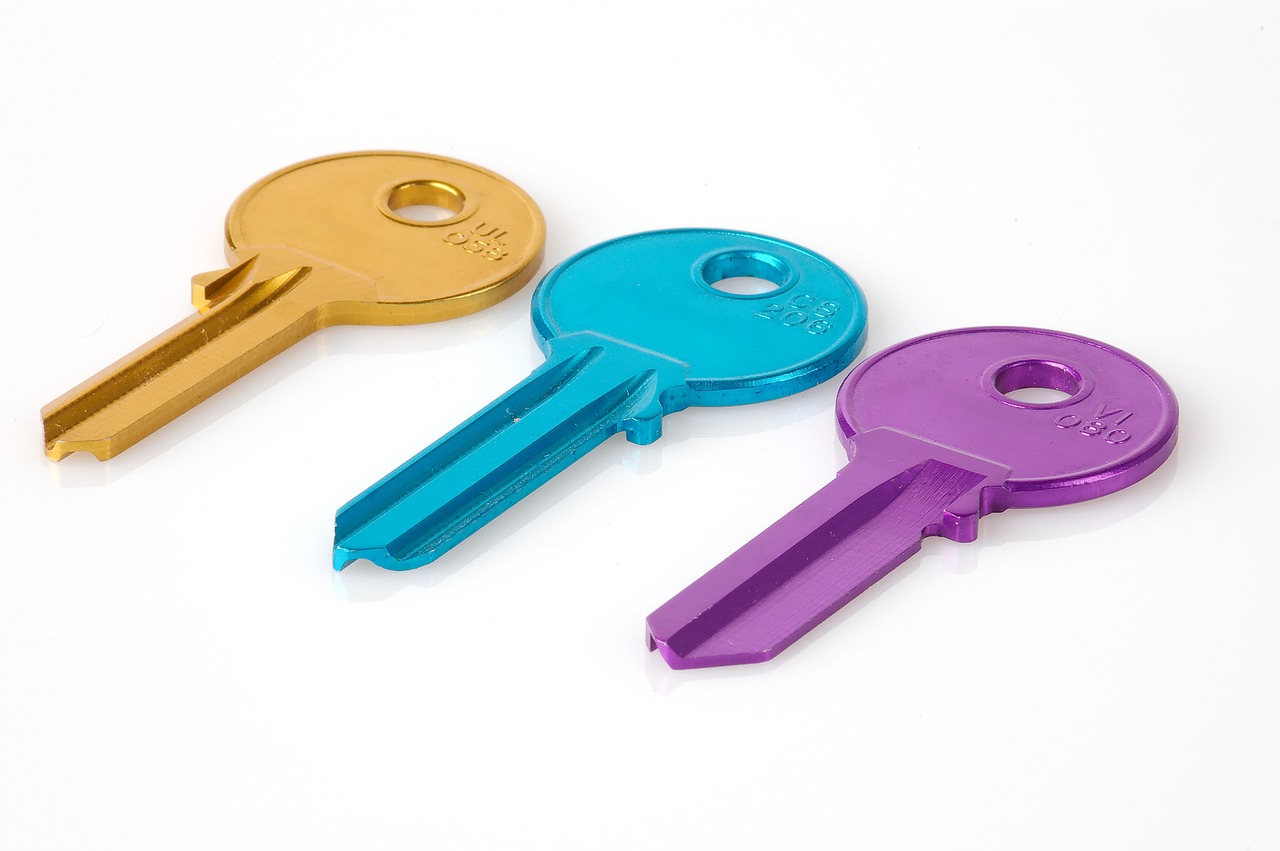
Key Performance Indicators
When it comes to evaluating the effectiveness of your trading strategy through backtesting, Key Performance Indicators (KPIs) serve as your guiding stars. These metrics provide crucial insights into how well your strategy performs under various market conditions. Just like a ship's captain relies on navigational tools to steer through turbulent waters, traders depend on KPIs to make informed decisions. So, what are the essential KPIs you should focus on?
First and foremost, let's talk about Return on Investment (ROI). This KPI measures the profitability of your strategy and is calculated by comparing the net profit to the initial investment. A higher ROI indicates a more successful strategy. For instance, if you invested $1,000 and made a profit of $200, your ROI would be 20%. This simple yet powerful metric helps you gauge whether your trading efforts are worth the time and resources.
Another key indicator is the Win Rate, which tells you the percentage of trades that were profitable. If you executed 100 trades and 55 were winners, your win rate would be 55%. While a high win rate is desirable, it's essential to balance it with the average profit per trade. Sometimes, a lower win rate with higher average profits can be more beneficial in the long run.
Additionally, you should keep an eye on the Maximum Drawdown. This KPI measures the largest drop from a peak to a trough in your trading equity, indicating the risk of your strategy. Understanding your maximum drawdown helps you prepare for the worst-case scenarios, allowing you to manage your emotions and avoid panic selling during tough times.
To illustrate these KPIs, consider the following table:
| KPI | Description | Example |
|---|---|---|
| Return on Investment (ROI) | Measures profitability | 20% from a $1,000 investment |
| Win Rate | Percentage of winning trades | 55% from 100 trades |
| Maximum Drawdown | Largest drop in equity | 30% decline from peak |
Lastly, don't overlook the Sharpe Ratio, which helps you understand the risk-adjusted return of your strategy. It compares the excess return of your strategy to its volatility. A higher Sharpe Ratio indicates a better risk-adjusted return, which is what every trader strives for. In essence, it tells you whether your profits are worth the risks you’re taking.
In summary, by focusing on these KPIs—ROI, Win Rate, Maximum Drawdown, and Sharpe Ratio—you can gain valuable insights into your trading strategy's performance. These metrics not only help you evaluate the past but also guide you in making informed adjustments for the future. So, keep these indicators close, and let them illuminate your trading journey!
- What is backtesting? Backtesting is the process of testing a trading strategy using historical data to evaluate its effectiveness.
- Why are KPIs important? KPIs help traders assess the performance of their strategies, allowing for informed decision-making and adjustments.
- How can I improve my trading strategy? By analyzing KPIs from backtesting results, you can identify strengths and weaknesses in your strategy and make necessary adjustments.
- What tools can I use for backtesting? There are various trading platforms and custom software options available that offer backtesting features.

Adjusting Strategies Based on Results
When it comes to trading, one of the most important skills you can develop is the ability to adapt your strategies based on the results of your backtesting. Think of it like refining a recipe; just because you followed the instructions doesn't mean the dish will always turn out perfect. Sometimes, you need to tweak the ingredients or the cooking time to get that ideal flavor. Similarly, after backtesting, you might find that certain elements of your strategy need adjustment to align better with market conditions.
After analyzing the backtesting results, it's crucial to identify which aspects of your strategy performed well and which didn't. For instance, did your strategy yield consistent profits during certain market conditions but falter during others? This insight is invaluable. You might need to consider the following:
- Market Conditions: If your strategy performed well in a bullish market but poorly in a bearish one, you may want to adjust your approach to account for different market dynamics.
- Entry and Exit Points: Analyze your entry and exit signals. Were they too aggressive or too conservative? Adjusting these points can significantly affect your overall performance.
- Risk Management: If the backtesting results show higher drawdowns than expected, it’s a clear sign to revisit your risk management strategies. Perhaps you need to tighten your stop-loss levels or reassess your position sizing.
Moreover, it’s essential to keep an eye on the Key Performance Indicators (KPIs) that matter most to your trading goals. KPIs like the Sharpe ratio, win/loss ratio, and maximum drawdown can provide further clarity on how to adjust your strategy. For example, if your win/loss ratio is low, it might be time to rethink your entry criteria or to implement a more robust filtering mechanism for trade signals.
Another important aspect of adjusting your strategy is the feedback loop. After making changes, conduct further backtesting to see how these adjustments perform. This iterative process is akin to a scientist conducting experiments; you hypothesize changes, test them, and analyze the results. Each cycle of testing and adjustment brings you closer to a finely-tuned trading strategy.
Lastly, remember that the market is always evolving. What works today might not work tomorrow. Staying flexible and open to change is key. As you gather more data and experience, your ability to adjust your strategies will not only improve but will also keep you ahead of the curve in an ever-changing trading landscape.
- What is backtesting? Backtesting is the process of testing a trading strategy using historical data to evaluate its effectiveness.
- How often should I adjust my trading strategy? It’s advisable to review and adjust your strategy regularly, especially after significant market changes or after completing a round of backtesting.
- What are key performance indicators? Key Performance Indicators (KPIs) are metrics used to evaluate the success of a trading strategy, such as win/loss ratio, Sharpe ratio, and maximum drawdown.
- Can backtesting guarantee future profits? No, backtesting cannot guarantee future profits, as market conditions can change. However, it can provide insights that help improve your strategy.
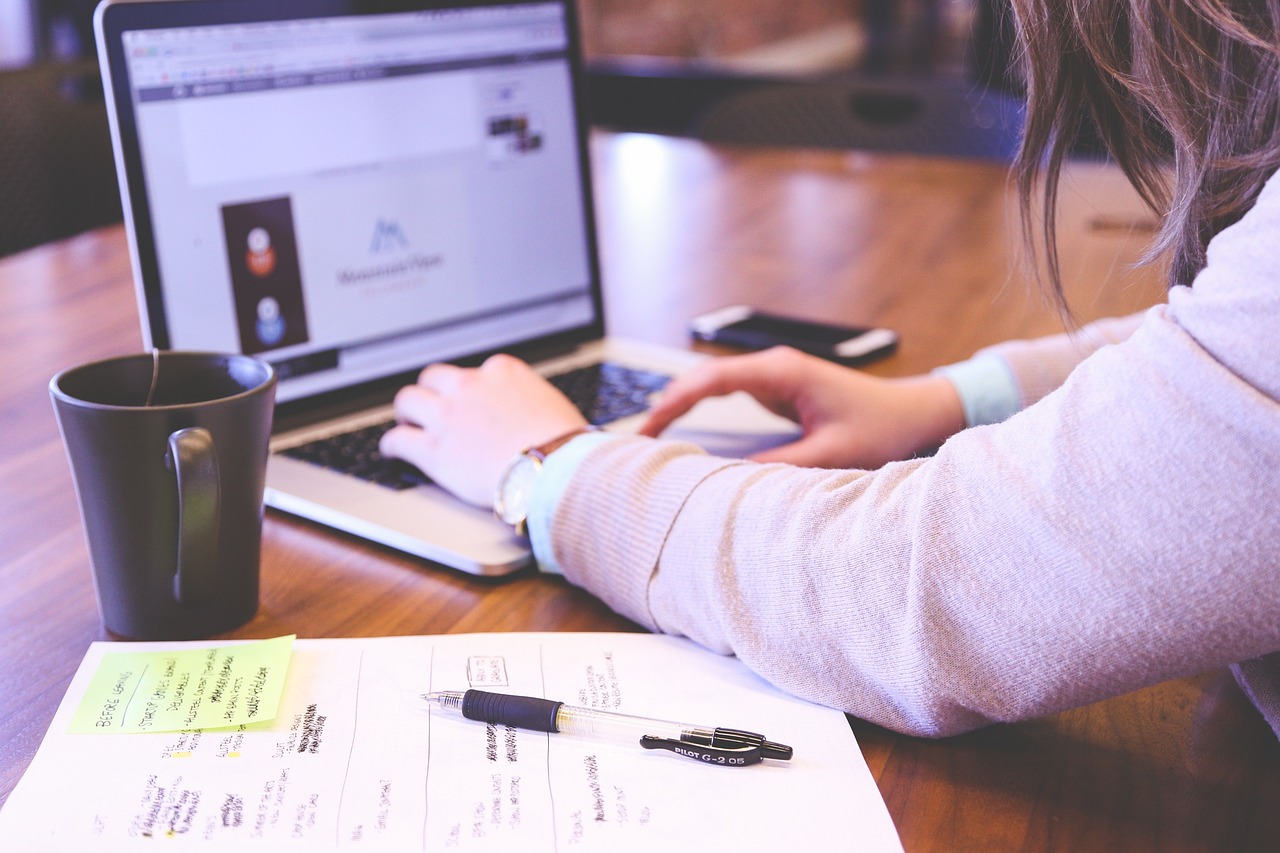
Conclusion
In conclusion, backtesting is not just a buzzword in the trading world; it’s a crucial component for anyone serious about improving their trading strategies. By simulating past market conditions, traders can gain valuable insights into how their strategies would have performed in different scenarios. This process allows for a deeper understanding of risk management, performance evaluation, and strategy optimization, which are vital for achieving success in live trading environments.
Moreover, backtesting provides a structured way to identify potential pitfalls, such as overfitting and ignoring changing market conditions. By being aware of these common mistakes, traders can refine their approaches and enhance their decision-making processes. It’s like preparing for a big game; you need to study your past performances to anticipate future challenges effectively.
As you embark on your backtesting journey, remember that the tools you choose can significantly impact your results. Whether you opt for user-friendly trading platforms or custom backtesting software, ensure that they align with your trading style and goals. The right tools can make all the difference, just like having the best gear can elevate your performance in sports.
Ultimately, the key to leveraging backtesting lies in understanding its results. Pay close attention to key performance indicators (KPIs) and be willing to adjust your strategies based on what the data reveals. This adaptability is crucial in the ever-changing landscape of trading. Embrace backtesting, and you’ll find yourself on a path toward greater confidence and success in your trading endeavors.
- What is backtesting? Backtesting is the process of testing a trading strategy using historical data to evaluate its effectiveness.
- Why is backtesting important? It helps traders refine their strategies, manage risks, and improve their chances of success in live trading.
- What are common mistakes in backtesting? Common mistakes include overfitting strategies to historical data and ignoring changing market conditions.
- What tools can I use for backtesting? There are various platforms and custom software available that offer backtesting features.
- How do I interpret backtesting results? Focus on key performance indicators and be prepared to adjust your strategies based on the outcomes.
Frequently Asked Questions
- What is backtesting in trading?
Backtesting is the process of testing a trading strategy using historical market data to see how it would have performed in the past. It's like taking a time machine to evaluate your strategy's effectiveness before risking real money!
- Why is backtesting important?
Backtesting is crucial because it helps traders refine their strategies and identify potential risks. By simulating past market conditions, traders can make informed decisions and increase their chances of success in live trading.
- What are the main benefits of backtesting?
Some key benefits of backtesting include enhanced risk management, performance evaluation, and strategy optimization. It allows traders to identify drawdowns, determine optimal position sizes, and analyze key performance metrics effectively.
- What are common mistakes to avoid during backtesting?
Common backtesting mistakes include overfitting the strategy to historical data and ignoring changing market conditions. It's important to strike a balance and consider various market environments to achieve reliable results.
- What tools are available for backtesting?
There are numerous tools and software options for backtesting, including trading platforms with built-in features and custom backtesting software. Each option has its unique benefits, catering to different trading needs.
- How do I interpret backtesting results?
Interpreting backtesting results involves analyzing key performance indicators (KPIs) to evaluate your strategy's success. Understanding these metrics will help you make informed adjustments to enhance your trading strategy.
- Can I adjust my strategy based on backtesting results?
Absolutely! Adapting your strategy based on backtesting results is vital for ongoing improvement. Use the insights gained to refine your approach and increase your chances of success in future trades.



